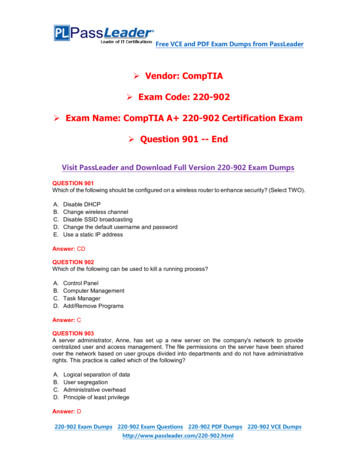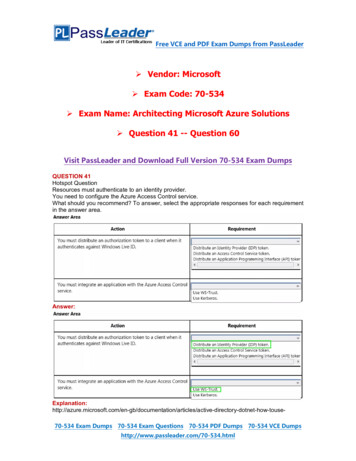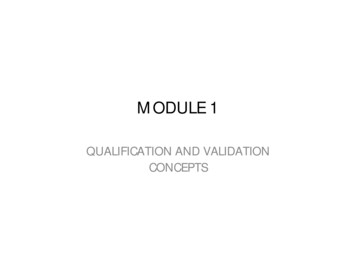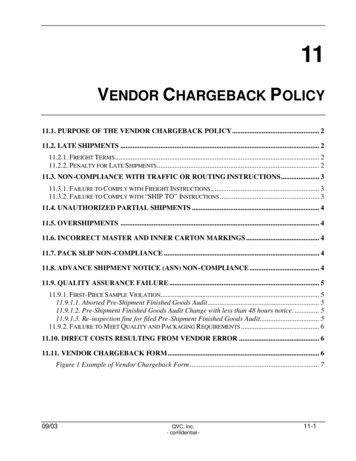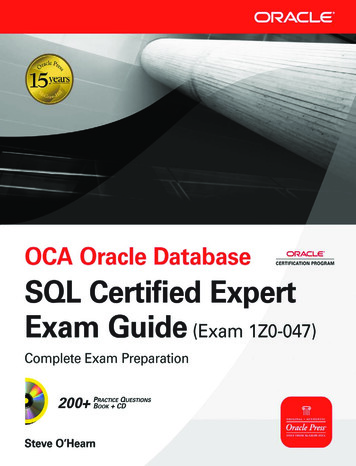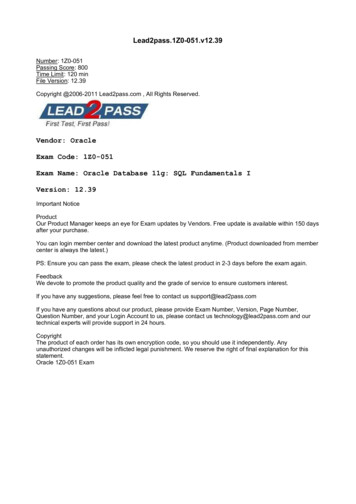
Transcription
Lead2pass.1Z0-051.v12.39Number: 1Z0-051Passing Score: 800Time Limit: 120 minFile Version: 12.39Copyright @2006-2011 Lead2pass.com , All Rights Reserved.Vendor: OracleExam Code: 1Z0-051Exam Name: Oracle Database 11g: SQL Fundamentals IVersion: 12.39Important NoticeProductOur Product Manager keeps an eye for Exam updates by Vendors. Free update is available within 150 daysafter your purchase.You can login member center and download the latest product anytime. (Product downloaded from membercenter is always the latest.)PS: Ensure you can pass the exam, please check the latest product in 2-3 days before the exam again.FeedbackWe devote to promote the product quality and the grade of service to ensure customers interest.If you have any suggestions, please feel free to contact us support@lead2pass.comIf you have any questions about our product, please provide Exam Number, Version, Page Number,Question Number, and your Login Account to us, please contact us technology@lead2pass.com and ourtechnical experts will provide support in 24 hours.CopyrightThe product of each order has its own encryption code, so you should use it independently. Anyunauthorized changes will be inflicted legal punishment. We reserve the right of final explanation for thisstatement.Oracle 1Z0-051 Exam
Exam AQUESTION 1Which is the valid CREATE TABLE statement?A.B.C.D.CREATE TABLE emp9 # (emp no NUMBER (4));CREATE TABLE 9emp # (emp no NUMBER(4));CREATE TABLE emp*123 (emp no NUMBER(4));CREATE TABLE emp9 # (emp no NUMBER(4), date DATE);Correct Answer: ASection: (none)ExplanationQUESTION 2Which two statements are true regarding tables? (Choose two.)A.B.C.D.E.F.A table name can be of any length.A table can have any number of columns.A column that has a DEFAULT value cannot store null values.A table and a view can have the same name in the same schema.A table and a synonym can have the same name in the same schema.The same table name can be used in different schemas in the same database.Correct Answer: EFSection: (none)ExplanationQUESTION 3Which two statements are true regarding constraints? (Choose two.)A.B.C.D.E.A foreign key cannot contain NULL values.A column with the UNIQUE constraint can contain NULL values.A constraint is enforced only for the INSERT operation on a table.A constraint can be disabled even if the constraint column contains data.All constraints can be defined at the column level as well as the table level.Correct Answer: BDSection: (none)ExplanationQUESTION 4Which two statements are true regarding constraints? (Choose two.)A.B.C.D.A foreign key cannot contain NULL values.The column with a UNIQUE constraint can store NULLS .A constraint is enforced only for an INSERT operation on a table.You can have more than one column in a table as part of a primary key.Correct Answer: BDSection: (none)ExplanationQUESTION 5Evaluate the following CREATE TABLE commands:
CREATE TABLE orders(ord no NUMBER(2) CONSTRAINT ord pk PRIMARY KEY,ord date DATE,cust id NUMBER(4));CREATE TABLE ord items(ord no NUMBER(2),item no NUMBER(3),qty NUMBER(3) CHECK (qty BETWEEN 100 AND 200),expiry date date CHECK (expiry date SYSDATE),CONSTRAINT it pk PRIMARY KEY (ord no,item no),CONSTRAINT ord fk FOREIGN KEY(ord no) REFERENCES orders(ord no));The above command fails when executed. What could be the reason?A.B.C.D.SYSDATE cannot be used with the CHECK constraint.The BETWEEN clause cannot be used for the CHECK constraint.The CHECK constraint cannot be placed on columns having the DATE data type.ORD NO and ITEM NO cannot be used as a composite primary key because ORD NO is also theFOREIGN KEY.Correct Answer: ASection: (none)ExplanationExplanation/Reference:QUESTION 6Evaluate the following SQL commands:SQL CREATE SEQUENCE ord seqINCREMENT BY 10START WITH 120MAXVALUE 9999NOCYCLE;SQL CREATE TABLE ord items(ord no NUMBER(4)DEFAULT ord seq.NEXTVAL NOT NULL,item no NUMBER(3),qty NUMBER(3) CHECK (qty BETWEEN 100 AND 200),expiry date date CHECK (expiry date SYSDATE),CONSTRAINT it pk PRIMARY KEY (ord no,item no),CONSTRAINT ord fk FOREIGN KEY(ord no) REFERENCES orders(ord no));The command to create a table fails. Identify the reason for the SQL statement failure? (Choose all thatapply.)A.B.C.D.You cannot use SYSDATE in the condition of a CHECK constraint.You cannot use the BETWEEN clause in the condition of a CHECK constraint.You cannot use the NEXTVAL sequence value as a DEFAULT value for a column.You cannot use ORD NO and ITEM NO columns as a composite primary key because ORD NO isalso the FOREIGN KEY.Correct Answer: ACSection: (none)ExplanationQUESTION 7Examine the structure and data in the PRICE LIST table:name Null Type
------ --------- ------PROD ID NOT NULL NUMBER(3)"FirstTest, FirstPass" - www.lead2pass.com 5Oracle 1Z0-051 ExamPROD PRICE VARCHAR2(10)PROD ID PROD PRICE---------- -----------100 234.55101 6,509.75102 1,234You plan to give a discount of 25% on the product price and need to display the discount amount in thesame format as the PROD PRICE.Which SQL statement would give the required result?A. SELECT TO CHAR(prod price* .25,' 99,999.99')FROM PRICE LIST;B. SELECT TO CHAR(TO NUMBER(prod price)* .25,' 99,999.00') FROM PRICE LIST;C. SELECT TO CHAR(TO NUMBER(prod price,' 99,999.99')* .25,' 99,999.00') FROM PRICE LIST;D. SELECT TO NUMBER(TO NUMBER(prod price,' 99,999.99')* .25,' 99,999.00') FROM PRICE LIST;Correct Answer: CSection: (none)ExplanationQUESTION 8View the Exhibit and examine the structure of the PROMOTIONS table. Which two SQL statements wouldexecute successfully? (Choose two.)A. UPDATE promotionsSET promo cost promo cost 100WHERE TO CHAR(promo end date, 'yyyy') '2000';B. SELECT promo begin dateFROM promotionsWHERE TO CHAR(promo begin date,'mon dd yy') 'jul 01 98';C. UPDATE promotionsSET promo cost promo cost 100WHERE promo end date TO DATE(SUBSTR('01-JAN-2000',8));D. SELECT TO CHAR(promo begin date,'dd/month')FROM promotionsWHERE promo begin date IN (TO DATE('JUN 01 98'), TO DATE('JUL 01 98'));Correct Answer: ABSection: (none)
ExplanationExplanation/Reference:"First Test, First Pass" - www.lead2pass.com 6Oracle 1Z0-051 ExamQUESTION 9View the Exhibit and examine the data in the PROMO NAME and PROMO END DATE columns of thePROMOTIONS table, and the required output format.Which two queries give the correct result? (Choose two.)A. SELECT promo name, TO CHAR(promo end date,'Day') ', 'TO CHAR(promo end date,'Month') ' 'TO CHAR(promo end date,'DD, YYYY') AS last dayFROM promotions;B. SELECT promo name,TO CHAR (promo end date,'fxDay') ', ' TO CHAR(promo end date,'fxMonth')''TO CHAR(promo end date,'fxDD, YYYY') AS last dayFROM promotions;C. SELECT promo name, TRIM(TO CHAR(promo end date,'Day')) ', ' TRIM(TO CHAR(promo end date,'Month')) ' 'TRIM(TO CHAR(promo end date,'DD, YYYY')) AS last dayFROM promotions;D. SELECTpromo name,TO CHAR(promo end date,'fmDay')','TO CHAR(promo end date,'fmMonth') ' 'TO CHAR(promo end date,'fmDD, YYYY') AS last dayFROM promotions;Correct Answer: CDSection: (none)ExplanationQUESTION 10View the Exhibit and examine the structure of the CUSTOMERS table. Using the CUSTOMERS table, y ouneed to generate a report that shows an increase in the credit limit by 15% for all customers.Customers whose credit limit has not been entered should have the message " Not Available" displayed.Which SQL statement would produce the required result?"First Test, First Pass" - www.lead2pass.com 7Oracle 1Z0-051 Exam
A.B.C.D.SELECT NVL(cust credit limit,'Not Available')*.15 "NEW CREDIT" FROM customers;SELECT NVL(cust credit limit*.15,'Not Available') "NEW CREDIT" FROM customers;SELECT TO CHAR(NVL(cust credit limit*.15,'Not Available')) "NEW CREDIT" FROM customers;SELECT NVL(TO CHAR(cust credit limit*.15),'Not Available') "NEW CREDIT" FROM customers;Correct Answer: DSection: (none)ExplanationQUESTION 11Examine the structure of the PROGRAMS table:name Null Type------ --------- ------PROG ID NOT NULL NUMBER(3)PROG COST NUMBER(8,2)START DATE NOT NULL DATEEND DATE DATEWhich two SQL statements would execute successfully? (Choose two.)A. SELECT NVL(ADD MONTHS(END DATE,1),SYSDATE)FROM programs;B. SELECT TO DATE(NVL(SYSDATE-END DATE,SYSDATE))FROM programs;C. SELECT NVL(MONTHS BETWEEN(start date,end date),'Ongoing') FROM programs;D. SELECT NVL(TO CHAR(MONTHS BETWEEN(start date,end date)),'Ongoing') FROM programs;Correct Answer: ADSection: (none)ExplanationQUESTION 12The PRODUCTS table has the following structure:name Null Type------ --------- ------PROD ID NOT NULL NUMBER(4)PROD NAME VARCHAR2(25)PROD EXPIRY DATE DATEEvaluate the following two SQL statements:"First Test, First Pass" - www.lead2pass.com 8Oracle 1Z0-051 Exam
SQL SELECT prod id, NVL2(prod expiry date, prod expiry date 15,'') FROM products;SQL SELECT prod id, NVL(prod expiry date, prod expiry date 15) FROM products;Which statement is true regarding the outcome?A.B.C.D.Both the statements execute and give different results.Both the statements execute and give the same result.Only the first SQL statement executes successfully.Only the second SQL statement executes successfully.Correct Answer: ASection: (none)ExplanationQUESTION 13Examine the structure of the INVOICE table.Name Null Type------ --------- ------INV NO NOT NULL NUMBER(3)INV DATE DATEINV AMT NUMBER(10,2)Which two SQL statements would execute successfully? (Choose two.)A. SELECT inv no,NVL2(inv date,'Pending','Incomplete')FROM invoice;B. SELECT inv no,NVL2(inv amt,inv date,'Not Available')FROM invoice;C. SELECT inv no,NVL2(inv date,sysdate-inv date,sysdate)FROM invoice;D. SELECT inv no,NVL2(inv amt,inv amt*.25,'Not Available') FROM invoice;Correct Answer: ACSection: (none)ExplanationQUESTION 14View the Exhibit and evaluate the structure and data in the CUST STATUS table.You issue the following SQL statement:SQL SELECT custno, NVL2(NULLIF(amt spent, credit limit), 0, 1000)"BONUS"FROM cust status;Which statement is true regarding the execution of the above query?A. It produces an error because the AMT SPENT column contains a null value.B. It displays a bonus of 1000 for all customers whose AMT SPENT is less than CREDIT LIMIT.C. It displays a bonus of 1000 for all customers whose AMT SPENT equals CREDIT LIMIT, orAMT SPENT is null .D. It produces an error because the TO NUMBER function must be used to convert the result of "FirstTest, First Pass" - www.lead2pass.com 9Oracle 1Z0-051 Examthe NULLIF function before it can be used by the NVL2 function.Correct Answer: CSection: (none)Explanation
QUESTION 15Which statement is true regarding the COALESCE function?A.B.C.D.It can have a maximum of five expressions in a list.It returns the highest NOT NULL value in the list for all rows.It requires that all expressions in the list must be of the same data type.It requires that at least one of the expressions in the list must have a NOT NULL value.Correct Answer: CSection: (none)ExplanationQUESTION 16View the Exhibit and examine the structure of the PROMOTIONS table. Using the PROMOTIONS table,you need to find out the average cost for all promos in the ranges 0-2000 and 2000-5000 in category AYou issue the following SQL statement:SQL SELECT AVG(CASEWHEN promo cost BETWEEN 0 AND 2000 AND promo category 'A' then promo costELSE null END) "CAT 2000A",AVG(CASEWHEN promo cost BETWEEN 2001 AND 5000 AND promo category 'A' THEN promo costELSE null END) "CAT 5000A"FROM promotions;What would be the outcome?A.B.C.D.It executes successfully and gives the required result.It generates an error because NULL cannot be specified as a return value.It generates an error because CASE cannot be used with group functions.It generates an error because multiple conditions cannot be specified for the WHEN clause.Correct Answer: ASection: (none)ExplanationExplanation/Reference:"First Test, First Pass" - www.lead2pass.com 10Oracle 1Z0-051 ExamQUESTION 17View the Exhibit and examine the structure of the PROMOTIONS table. Which SQL statements are valid?(Choose all that apply.)
A. SELECT promo id, DECODE(NVL(promo cost,0), promo cost, promo cost * 0.25, 100) "Discount"FROM promotions;B. SELECT promo id, DECODE(promo cost, 10000,DECODE(promo category, 'G1', promo cost *.25, NULL),NULL) "Catcost"FROM promotions;C. SELECT promo id, DECODE(NULLIF(promo cost, 10000),NULL, promo cost*.25, 'N/A') "Catcost"FROM promotions;D. SELECT promo id, DECODE(promo cost, 10000, 'High', 10000, 'Low') "Range"FROM promotions;Correct Answer: ABSection: (none)ExplanationQUESTION 18Examine the data in the PROMO BEGIN DATE column of the PROMOTIONS table:PROMO BEGIN 8-oct-9822-aug-99You want to display the number of promotions started in 1999 and 2000.Which query gives the correct output?A. SELECT SUM(DECODE(SUBSTR(promo begin date,8),'00',1,0)) "2000", SUM(DECODE(SUBSTR(promo begin date,8),'99',1,0)) "1999"FROM promotions;B. SELECT SUM(CASE TO CHAR(promo begin date,'yyyy') WHEN '99' THEN 1 ELSE 0 END) "1999",SUM(CASE TO CHAR(promo begin date,'yyyy') WHEN '00' THEN 1 ELSE 0 END) "2000" FROMpromotions;"First Test, First Pass" - www.lead2pass.com 11Oracle 1Z0-051 ExamC. SELECT COUNT(CASE TO CHAR(promo begin date,'yyyy') WHEN '99' THEN 1 ELSE 0 END)"1999", COUNT(CASE TO CHAR(promo begin date,'yyyy') WHEN '00' THEN 1 ELSE 0 END) "2000"FROM promotions;D. SELECT COUNT(DECODE(SUBSTR(TO CHAR(promo begin date,'yyyy'), 8), '1999', 1, 0)) "1999",COUNT(DECODE(SUBSTR(TO CHAR(promo begin date,'yyyy'), 8),'2000', 1,0)) "2000"FROM promotions;
Correct Answer: ASection: (none)ExplanationQUESTION 19Examine the structure of the TRANSACTIONS table:name Null Type------------- ----------- -------------------TRANS ID NOT NULL NUMBER(3)CUST NAME VARCHAR2(30)TRANS DATE TIMESTAMPTRANS AMT NUMBER(10,2)You want to display the date, time, and transaction amount of transactions that where done before 12 noon.The value zero should be displayed for transactions where the transaction amount has not been entered.Which query gives the required result?A. SELECT TO CHAR(trans date,'dd-mon-yyyy hh24:mi:ss'),TO CHAR(trans amt,' 99999999D99')FROM transactionsWHERE TO NUMBER(TO DATE(trans date,'hh24')) 12 AND COALESCE(trans amt,NULL) NULL;B. SELECT TO CHAR(trans date,'dd-mon-yyyy hh24:mi:ss'),NVL(TO CHAR(trans amt,' 99999999D99'),0)FROM transactionsWHERE TO CHAR(trans date,'hh24') 12;C. SELECT TO CHAR(trans date,'dd-mon-yyyy hh24:mi:ss'),COALESCE(TO NUMBER(trans amt,' 99999999.99'),0)FROM transactionsWHERE TO DATE(trans date,'hh24') 12;D. SELECT TO DATE (trans date,'dd-mon-yyyy hh24:mi:ss'),NVL2(trans amt,TO NUMBER(trans amt,' 99999999.99'), 0) FROM transactionsWHERE TO DATE(trans date,'hh24') 12;Correct Answer: BSection: (none)ExplanationQUESTION 20Examine the structure of the TRANSACTIONS table:name Null Type----------- ----------- -------------------TRANS ID NOT NULL NUMBER(3)CUST NAME VARCHAR2(30)TRANS DATE DATE"FirstTest, FirstPass" - www.lead2pass.com 12Oracle 1Z0-051 ExamTRANS AMT NUMBER(10,2)You want to display the transaction date and specify whether it is a weekday or weekend.Evaluate the following two queries:SQL SELECT TRANS DATE,CASEWHEN TRIM(TO CHAR(trans date,'DAY')) IN ('SATURDAY','SUNDAY') THEN 'weekend'ELSE 'weekday'END "Day Type"FROM transactions;
SQL SELECT TRANS DATE, CASEWHEN TO CHAR(trans date,'DAY') BETWEEN 'MONDAY' AND 'FRIDAY' THEN 'weekday'ELSE 'weekend'END "Day Type"FROM transactions;Which statement is true regarding the above queries?A.B.C.D.Both give wrong results.Both give the correct result.Only the first query gives the correct result.Only the second query gives the correct result.Correct Answer: CSection: (none)ExplanationQUESTION 21View the Exhibit for the structure of the STUDENT and FACULTY tables.You need to display the faculty name followed by the number of students handled by the faculty at the baselocation.Examine the following two SQL statements:Statement 1SQL SELECT faculty name,COUNT(student id)FROM student JOIN facultyUSING (faculty id, location id)GROUP BY faculty name;Statement 2"First Test, First Pass" - www.lead2pass.com 13Oracle 1Z0-051 ExamSQL SELECT faculty name,COUNT(student id)FROM student NATURAL JOIN facultyGROUP BY faculty name;Which statement is true regarding the outcome?A.B.C.D.Only s tatement 1 executes successfully and gives the required result.Only statement 2 executes successfully and gives the required result.Both statements 1 and 2 execute successfully and give different results.Both statements 1 and 2 execute successfully and give the same required result.
Correct Answer: DSection: (none)ExplanationQUESTION 22Which two statements are true regarding the USING clause in table joins? (Choose two .)A.B.C.D.It can be used to join a maximum of three tables.It can be used to restrict the number of columns used in a NATURAL join.It can be used to access data from tables through equijoins as well as nonequijoins.It can be used to join tables that have columns with the same name and compatible data types.Correct Answer: BDSection: (none)ExplanationQUESTION 23Examine the structure of the CUSTOMERS table:name Null Type----------- ----------- -------------------CUSTNO NOT NULL NUMBER(3)CUSTNAME NOT NULL VARCHAR2(25)CUSTADDRESS VARCHAR2(35)CUST CREDIT LIMIT NUMBER(5)CUSTNO is the PRIMARY KEY in the table. You want to find out if any customers' details have beenentered more than once using different CUSTNO, by listing all the duplicate names. Which two methodscan you use to get the required result? (Choose two.)A.B.C.D.E.self-joinsubqueryfull outer-join with self-joinleft outer-join with self-joinright outer-join with self-joinCorrect Answer: ABSection: (none)ExplanationQUESTION 24View the Exhibits and examine the structures of the PRODUCTS, SALES, and CUSTOMERS tables."First Test, First Pass" - www.lead2pass.com 14Oracle 1Z0-051 Exam
You issue the following query:SQL SELECT p.prod id,prod name,prod list price,quantity sold,cust last nameFROM products p NATURAL JOIN sales s NATURAL JOIN customers c WHERE prod id 148;Which statement is true regarding the outcome of this query?A.B.C.D.It executes successfully.It produces an error because the NATURAL join can be used only with two tables.It produces an error because a column used in the NATURAL join cannot have a qualifier.It produces an error because all columns used in the NATURAL join should have a qualifier.Correct Answer: CSection: (none)ExplanationQUESTION 25View the Exhibits and examine the structures of the PRODUCTS, SALES, and CUSTOMERS tables.You need to generate a report that gives details of the customer's last name, name of the product, and thequantity sold for all customers in 'Tokyo' ."First Test, First Pass" - www.lead2pass.com 15Oracle 1Z0-051 Exam
Which two queries give the required result? (Choose two.)A. SELECT c.cust last name,p.prod name, s.quantity soldFROM sales s JOIN products pUSING(prod id)JOIN customers cUSING(cust id)WHERE c.cust city 'Tokyo';B. SELECT c.cust last name, p.prod name, s.quantity soldFROM products p JOIN sales s JOIN customers cON(p.prod id s.prod id)ON(s.cust id c.cust id)WHERE c.cust city 'Tokyo';C. SELECT c.cust last name, p.prod name, s.quantity soldFROM products p JOIN sales sON(p.prod id s.prod id)JOIN customers cON(s.cust id c.cust id)AND c.cust city 'Tokyo';D. SELECT c.cust id,c.cust last name,p.prod id, p.prod name, s.quantity sold FROM products p JOINsales s USING(prod id)JOIN customers c"First Test, First Pass" - www.lead2pass.com 16Oracle 1Z0-051 ExamUSING(cust id)WHERE c.cust city 'Tokyo';Correct Answer: ACSection: (none)
ExplanationQUESTION 26View the Exhibit and examine the structure of the PROMOTIONS, SALES, and CUSTOMER tables.You need to generate a report showing the promo name along with the customer name for all products thatwere sold during their promo campaign and before 30th October 2007.You issue the following query:SQL SELECT promo name,cust nameFROM promotions p JOIN sales sON(time id BETWEEN promo begin date AND promo end date) JOIN customer cON (s.cust id c.cust id) AND time id '30-oct-2007';Which statement is true regarding the above query?A.B.C.D.It executes successfully and gives the required result.It executes successfully but does not give the required result.It produces an error because the join order of the tables is incorrect.It produces an error because equijoin and nonequijoin conditions cannot be used in the same SELECTstatement.Correct Answer: BSection: (none)ExplanationExplanation/Reference:"First Test, First Pass" - www.lead2pass.com 17Oracle 1Z0-051 ExamQUESTION 27View the Exhibit and examine the data in the PROJ TASK DETAILS table.
The PROJ TASK DETAILS table stores information about tasks involved in a project and the relationbetween them.The BASED ON column indicates dependencies between tasks. Some tasks do not depend on thecompletion of any other tasks.You need to generate a report showing all task IDs, the corresponding task ID they are dependent on, andthe name of the employee in charge of the task it depends on.Which query would give the required result?A. SELECT p.task id, p.based on, d.task in chargeFROM proj task details p JOIN proj task details dON (p.based on d.task id);B. SELECT p.task id, p.based on, d.task in chargeFROM proj task details p LEFT OUTER JOIN proj task details d ON (p.based on d.task id);C. SELECT p.task id, p.based on, d.task in chargeFROM proj task details p FULL OUTER JOIN proj task details d ON (p.based on d.task id);D. SELECT p.task id, p.based on, d.task in chargeFROM proj task details p JOIN proj task details dON (p.task id d.task id);Correct Answer: BSection: (none)ExplanationQUESTION 28Examine the data in the CUSTOMERS table:CUSTNO CUSTNAME CITY--------- --------- ---------1 KING SEATTLE2 GREEN BOSTON3 KOCHAR SEATTLE4 SMITH NEW YORKYou want to list all cities that have more than one customer along with the customer details.Evaluate the following query:SQL SELECT c1.custname, c1.cityFROM Customers c1 Customers c2ON (c1.city c2.city AND c1.custname c2.custname);Which two JOIN options can be used in the blank in the above query to give the correct output? (Choosetwo.)A. JOIN"First Test, First Pass" - www.lead2pass.com 18Oracle 1Z0-051 ExamB. NATURAL JOINC. LEFT OUTER JOIND. FULL OUTER JOINE. RIGHT OUTER JOIN
Correct Answer: AESection: (none)ExplanationQUESTION 29View the Exhibits and examine the structures of the CUSTOMERS, SALES, and COUNTRIES tables.You need to generate a report that shows all country names, with corresponding customers (if any) andsales details (if any), for all customers.Which FROM clause gives the required result?A. FROM sales JOIN customers USING (cust id)FULL OUTER JOIN countries USING (country id);B. FROM sales JOIN customers USING (cust id)RIGHT OUTER JOIN countries USING (country id);C. FROM customers LEFT OUTER JOIN sales USING (cust id)RIGHT OUTER JOIN countries USING (country id);D. FROM customers LEFT OUTER JOIN sales USING (cust id)LEFT OUTER JOIN countries USING (country id);Correct Answer: CSection: (none)ExplanationQUESTION 30View the Exhibits and examine the structures of the PROMOTIONS and SALES tables.Evaluate the following SQL statement:SQL SELECT p.promo id, p.promo name, s.prod idFROM sales s RIGHT OUTER JOIN promotions pON (s.promo id p.promo id);"FirstTest, FirstPass" - www.lead2pass.com 19Oracle 1Z0-051 ExamWhich statement is true regarding the output of the above query?A. It gives the details of promos for which there have been sales.B. It gives the details of promos for which there have been no sales.
C. It gives details of all promos irrespective of whether they have resulted in a sale or not.D. It gives details of product ID s that have been sold irrespective of whether they had a promo or not.Correct Answer: CSection: (none)ExplanationQUESTION 31View the Exhibit and examine the data in the EMPLOYEES table:You want to display all the employee names and their corresponding manager names.Evaluate the following query:SQL SELECT e.employee name "EMP NAME", m.employee name "MGR NAME" FROM employees eemployees mON e.manager id m.employee id;Which JOIN option can be used in the blank in the above query to get the required output?A.B.C.D.only inner JOINonly FULL OUTER JOINonly LEFT OUTER JOINonly RIGHT OUTER JOINCorrect Answer: CSection: (none)ExplanationQUESTION 32View the Exhibit and examine the structure of the PRODUCT, COMPONENT, and PDT COMP tables."First Test, First Pass" - www.lead2pass.com 20Oracle 1Z0-051 Exam
In PRODUCT table, PDTNO is the primary key.In COMPONENT table, COMPNO is the primary key.In PDT COMP table, (PDTNO,COMPNO) is the primary key, PDTNO is the foreign key referencingPDTNO in PRODUCT table and COMPNO is the foreign key referencing the COMPNO in COMPONENTtable.You want to generate a report listing the product names and their corresponding component names, if thecomponent names and product names exist.Evaluate the following query:SQL SELECT pdtno,pdtname, compno,compnameFROM product pdt compUSING (pdtno) component USING(compno)WHERE compname IS NOT NULL;Which combination of joins used in the blanks in the above query gives the correct output?A.B.C.D.JOIN; JOINFULL OUTER JOIN; FULL OUTER JOINRIGHT OUTER JOIN; LEFT OUTER JOINLEFT OUTER JOIN; RIGHT OUTER JOINCorrect Answer: CSection: (none)ExplanationQUESTION 33View the Exhibit and examine the structure of the SALES and PRODUCTS tables. In the SALES table,PROD ID is the foreign key referencing PROD ID in the PRODUCTS table, You want to list each productID and the number of times it has been sold.Evaluate the following query:SQL SELECT p.prod id, COUNT(s.prod id)FROM products p sales sON p.prod id s.prod idGROUP BY p.prod id;Which two JOIN options can be used in the blank in the above query to get the required output?"First Test, First Pass" - www.lead2pass.com 21Oracle 1Z0-051 Exam(Choose two.)
A.B.C.D.JOINFULL OUTER JOINLEFT OUTER JOINRIGHT OUTER JOINCorrect Answer: BCSection: (none)ExplanationQUESTION 34Which two statements are true regarding subqueries? (Choose two.)A.B.C.D.E.A subquery can retrieve zero or more rows.Only two subqueries can be placed at one level.A subquery can be used only in SQL query statements.A subquery can appear on either side of a comparison operator.There is no limit on the number of subquery levels in the WHERE clause of a SELECT statement.Correct Answer: ADSection: (none)ExplanationQUESTION 35Where can subqueries be used? (Choose all that apply.)A.B.C.D.E.F.field names in the SELECT statementthe FROM clause in the SELECT statementthe HAVING clause in the SELECT statementthe GROUP BY clause in the SELECT statementthe WHERE clause in only the SELECT statementthe WHERE clause in SELECT as well as all DML statementsCorrect Answer: ABCFSection: (none)ExplanationExplanation/Reference:"First Test, First Pass" - www.lead2pass.com 22Oracle 1Z0-051 Exam
QUESTION 36Which three statements are true regarding subqueries? (Choose three.)A.B.C.D.E.F.Subqueries can contain GROUP BY and ORDER BY clauses.Main query and subquery can get data from different tables.Main query and subquery must get data from the same tables.Subqueries can contain ORDER BY but not the GROUP BY clause.Only one column or expression can be compared between the main query and subquery.Multiple columns or expressions can be compared between the main query and subquery.Correct Answer: ABFSection: (none)ExplanationQUESTION 37View the Exhibits and examine PRODUCTS and SALES tables.You issue the following query to display product name and the number of times the product has been sold:SQL SELECT p.prod name, i.item cntFROM (SELECT prod id, COUNT(*) item cntFROM salesGROUP BY prod id) i RIGHT OUTER JOIN products pON i.prod id p.prod id;What happens when the above statement is executed?A. The statement executes successfully and produces the required output.B. The statement produces an error because ITEM CNT cannot be displayed in the outer query.C. The statement produces an error because a subquery in the FROM clause and outer-joins cannot beused together.D. The statement produces an error because the GROUP BY clause cannot be used in a subquery in the"First Test, First Pass" - www.lead2pass.com 23Oracle 1Z0-051 ExamFROM clause.
Correct Answer: ASection: (none)ExplanationQUESTION 38View the Exhibit and examine the structure of the PRODUCTS table. Which two tasks would requiresubqueries? (Choose two.)A.B.C.D.E.Display the minimum list price for each product status.Display all suppliers whose list price is less than 1000.Display the number of products whose list price is more than the average list price.Display the total number of products supplied by supplier 102 and have product status as 'obsolete'.Display all products whose minimum list price is more than the average list price of products and havethe status 'orderable'.Correct Answer: CESection: (none)ExplanationQUESTION 39Which statement is true regarding subqueries?A.B.C.D.The LIKE operator cannot be used with single- row subqueries.The NOT IN operator is equivalent to IS NULL with single- row subqueries. ANY and ALL operators have the same functionality in multiple- row subqueries.The NOT operator can be used with IN, ANY, and ALL operators in multiple- row subqueries.Correct Answer: DSection: (none)ExplanationQUESTION 40Which three statements are true about multiple-row subqueries? (Choose three.)A.B.C.D.E.F.They can contain a subquery within a subquery.They can return multiple columns as well as rows.They cannot contain a subquery within a subquery.They can return only one column but multiple rows.They can contain group functions and GROUP BY and HAVING clauses.They can contain group functions and the GROUP BY clause, but not the HAVING clause.Correct Answer: ABESection: (none)Explanation
Explanation/Reference:"First Test, First Pass" - www.lead2pass.com 24Oracle 1Z0-051 ExamQUESTION 41View the Exhibit and examine the structure of CUSTO
Aug 01, 2012 · Exam Name: Oracle Database 11g: SQL Fundamentals I Version: 12.39 Important Notice Product Our Product Manager keeps an eye for Exam updates by Vendors. . Evaluate the following SQL commands: SQL CREATE SEQUENCE ord_seq INCREMENT BY 10 START WITH 120 . Oracle 1Z0-05

